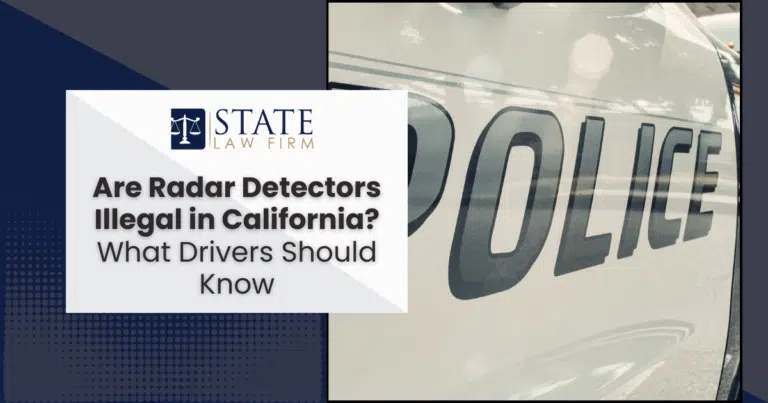Staying informed on California traffic laws isn’t just about avoiding tickets—it’s about keeping yourself and others safe on the road. One hot topic among drivers is the use of radar detectors—those compact devices designed to alert drivers to nearby speed enforcement. But what’s legal and what’s not when it comes to radar detection in California?
With over 3,800 people killed in traffic-related incidents in California in 2022 alone (source), understanding and following state driving laws is more important than ever. Whether you’re a daily commuter or an occasional road-tripper, knowing the rules can help you avoid costly penalties—and more importantly, avoid becoming another statistic.
At State Law Firm’s Sherman Oaks office, our team of dedicated personal injury attorneys helps victims of car accidents navigate the legal system every day. As a boutique firm run by young, ambitious attorneys evolving into trial-ready litigators, we’re committed to educating the public about legal risks and helping them protect their rights on the road.
In this article, we’ll break down how radar detectors work, explore California’s legal stance on these devices, and outline what drivers need to know to stay compliant and safe.
Understanding Radar Detectors: How They Work
Radar detectors are electronic devices that alert drivers when their vehicle is approaching a police radar gun used for speed enforcement. These tools operate by scanning for specific radio frequencies emitted by radar devices. Once a radar signal is detected, the unit provides a visual and/or audio alert, giving drivers the opportunity to slow down before they’re clocked.
There are several types of radar detection technologies commonly in use:
- X-band: One of the oldest bands, still used in some rural areas.
- K-band: A widely used radar frequency among law enforcement.
- Ka-band: The most frequently used and most accurate modern police radar.
- Laser/LIDAR detectors: These detect infrared laser beams used in speed traps, but the window for reaction is much shorter.
Pro tip: High-end models like the Uniden R7 and R8 not only scan multiple bands but can also detect red light and speed cameras through GPS data.
The Legal Landscape: Are Radar Detectors Legal or Illegal in California?
In California, radar detectors are legal for use in private vehicles—but there’s a catch.
While drivers are allowed to own and operate radar detectors, mounting them on your windshield is illegal under California Vehicle Code Section 26708(a)(1), which prohibits placing any object that obstructs the driver’s clear view through the windshield.
That means if you’re using a radar detector like the Uniden R7, you’ll need to find a compliant mounting option, such as:
- Dash mounts are placed low and out of your line of sight
- Rearview mirror mounts (e.g., BlendMount or visor clips)
- Stealth hardwiring routed through the A-pillar and tapped into fuse boxes or mirror ports.
Keep in mind: Even though the devices themselves are allowed, visible or poorly mounted units can invite extra scrutiny from law enforcement.
Exceptions and Restrictions: Where Can You Use Radar Detectors in California?
Though radar detectors are legal in California for personal vehicles, they’re strictly prohibited in commercial vehicles over 10,000 pounds per federal law (49 CFR § 392.71).
Additionally, here’s where to tread carefully:
- Military bases: Most do not permit radar detectors of any kind.
- Border crossings: Detectors may be frowned upon when entering Mexico or Canada.
- Windshield-mounted units: As noted above, this is the most common pitfall—legal device, illegal placement.
Pro tip: Some drivers choose visor mounts or install stealth brackets high and tight near the headliner, making the device virtually invisible to anyone outside the vehicle.
The Consequences of Using a Radar Detector Illegally in California
While the radar detector itself may be legal, improper placement can still lead to penalties. If you’re pulled over and the officer determines your device obstructs your view or is mounted unlawfully, you may receive:
- A fix-it ticket for a violation of California’s obstruction law
- Fines (typically in the $25–$200 range, depending on circumstances)
- Increased attention during the stop if the device is visible or poorly installed
What’s more, using radar detectors irresponsibly, such as flying past a speed trap at dangerous speeds, can reduce your credibility if you’re later involved in an accident and pursuing damages.
At State Law Firm, we’ve worked with countless accident victims who didn’t see the crash coming, regardless of the technology in their car. A radar detector isn’t a shield; it’s just a tool.
Alternatives to Radar Detectors: What Drivers Should Consider
If you’re hesitant to install a radar detector—or simply want more functionality—there are plenty of modern alternatives that offer safer and more lawful ways to stay aware on the road.
Consider these options:
- Waze or other GPS-based apps that alert you to reported police presence and speed traps
- Dash cams with speed monitoring and built-in driver alerts
- Vehicle HUD displays that integrate legal speed alerts and map overlays.ys
- Speed-monitoring subscription services that plug into your OBD-II port
Pro tip: Many drivers have shifted toward using apps over traditional detectors. While not as precise, community-driven alerts offer valuable real-time data without the legal gray area.
Final Thoughts
Radar detectors can be a helpful addition for drivers who want to stay informed, but they come with responsibility. Misusing or mounting one improperly in California could put you at risk of fines, increased scrutiny, or worse—distraction while driving.
If you’ve been involved in a car accident and believe your rights were violated or your safety compromised, State Law Firm’s Sherman Oaks car accident attorneys are here to support you. As a boutique personal injury firm with a fresh, modern approach, we’re passionate about taking on tough cases and fighting for the outcomes our clients deserve.
Let the road be a place of focus, not friction. And remember—there’s no better safety tool than staying alert, informed, and within the law.


